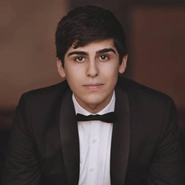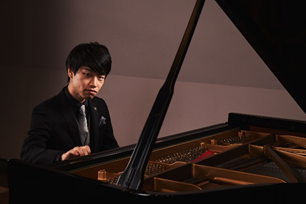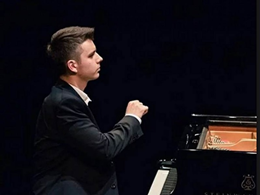November 14, 2020, 3:00pm
YouTube Link: https://youtu.be/GnOnZWbhers
Vivianne Cheng - https://www.vivi-anne.com/
One of the youngest Steinway Artists in the world, Vivianne Cheng has performed extensively throughout Europe and the United States. She was born in North Carolina, where she gave her debut solo recital at the age of ten; we had hoped to bring her home to Raleigh/Cary. Since then, Vivianne has made appearances in the most prestigious venues including Carnegie Hall, Het Concertgebouw, Musikverein, Salle Cortot, Lincoln Center, Wonderfeel Festival, Festival Ljubljana, and Verbier Festival Academy. Highlights of the current season include solo recitals in Austria, France, Latvia, Netherlands, Spain, USA; and appearances at the Mahler Festival in Concertgebouw, live radio performance on NPO Radio 4, world premiere at the Aspekte Festival in Salzburg, and a new CD release consisting of 48 Préludes.
Recorded in Amsterdam in the Bernard Haitinkzaal.
Tchaikovsky: Thème original et variations, Op. 19
Rachmaninoff: Variations on a Theme of Corelli, Op. 42
Shostakovich: Sonata No. 2 in B minor, Op. 61
Scriabin: Valse in A-flat major, Op. 38

November 15, 2020, 3:00pm
YouTube Link: https://youtu.be/aKU-Nx-o1Dw
Evren Ozel - https://www.chopin.org/evren-ozel
Evren Ozel started piano at age 3 in his hometown of Minneapolis. He has performed with the Cleveland Orchestra, Jacksonville Symphony, Minnesota Orchestra, and Boston Pops and won first prize at the 2016 Boston Symphony Concerto Competition, second prize at the 2016 Thomas and Evon Cooper International Competition, and second prize as well as the Mozart and Chopin special prizes at the 2018 Dublin International Competition. He received the second prize at the 2020 U.S. National Chopin Competition, as well as Best Mazurka and Best Polonaise. An avid chamber musician, Ozel has performed with the Jupiter Symphony Chamber Players, and participated in Marlboro Music Festival and ChamberFest Cleveland. In the 2020-2021 season, he will appear with the U.S. Chopin Foundation in Miami and the Gilmore Rising Stars Series in Kalamazoo. He currently studies at New England Conservatory. Since 2014 he has been a student of Wha Kyung Byun.
Recorded in Fraser Performance Studio, WGBH, Boston.
Bach: Partita No. 5 in G Major, BWV 829
Mozart: Sonata No. 15 in F Major, K. 533
—intermission—
Chopin:
Sonata in B flat minor, Op. 35
Impromptu in F sharp Major, Op. 36
Polonaise-Fantaisie in A flat Major, Op. 61

November 21, 2020 at 3:00pm
YouTube Link: https://youtu.be/US_yyFL_FnY
Keigo Mukawa - https://chanelnexushall.jp/en/artists/keigo_mukawa/
Born in Aichi prefecture in 1993, Keigo Mukawa has most recently won second prize in the Long-Thibaud-Crespin competition in France (1919) and played concerts in Kraków in the Czartoryski Museum this year. In 2014, he was accepted to the Conservatoire National Supérieur de Musique et de Danse de Paris. Other achievements in international piano competitions include 2nd prize at the 25th Epinal International Piano Competition in 2015 and 2nd prize in the 18th Ile de France International Piano Competition in 2016. He has performed with the Tokyo Philharmonic Orchestra, Central Aichi Symphony Orchestra, Kanagawa Philharmonic Orchestra, Chubu Philharmonic Orchestra, and the Lorraine National Orchestra in France. In addition to playing as a soloist, he has actively played chamber music. He has studied under Frank Braley, Haruko Ueda, Théodore Paraskivesco, Susumu Aoyagi and Yukio Yokoyama, and is the recipient of the Rohm Music Foundation and the 46th Ezoe Memorial Foundation Scholarship.
Recorded in Krakow in the Czartoryski Museum
Chopin: Variations in E major “Der schweitzer Bub“
Paderewski:
Melodie in G flat major, Op. 16, No. 2
Valse Caprice in E flat major, Op. 10, No. 5
Beethoven: Sonata No. 30 in E Major, Op. 109
Vivace ma non troppo - Adagio espressivo
Prestissimo
Andante molto contabile ed esprssivo
Prokofiev: Piano Sonata no. 2 in D minor, Op. 14
Allegro ma non troppo
Scherzo – Allegro marcato
Andante
Vivace – Moderato – Vivace
Rachmaninov: Moment musical, Op. 16, No. 3

November 22, 2020, 3:00pm
YouTube Link: https://youtu.be/p-K5npKBdEg
Kamil Pacholec - https://kamilpacholec.com/en/
Kamil Pacholec played at our Fourth and Fifth Festivals in Raleigh where he gained an extraordinary success. He also played at the residence of the Ambassador of Poland to climax the Fifth Paderewski Festival and inaugurate the Raleigh series in Washington, DC. In 2019 at the 11th Paderewski International Piano Competition in Bydgoszcz he won the 2nd prize, the award for the best performance of Mozart’s piano concerto, the Jerzy Kolanowski award for the best performance of Chopin’s works, the Pomeranian Philharmonic award for the best performance of Paderewski’s works and additional prizes in the form of invitations to play in Poland, USA, Brazil, Colombia, and Ukraine. He has played concerts in Poland, France, Italy, Ukraine, USA and Japan. He has given recitals at several renowned piano festivals, garnering many enthusiastic reviews, emphasizing “the perfect combination of youthful freshness with perfect technique and a deep understanding of the music he performs.”
Recorded in Warsaw in the Filharmonia Narodowa.
Mozart: Fantasy in D minor, K 397
Paderewski:
Variations in A major, Op. 16 No. 3
Mazurka in A minor Op. 9 No. 2
Mazurka in A Major Op. 9 No. 3
Saraband in B minor Op. 14 No. 2
Cracovienne fantastique in B major Op. 14 No. 6
Chopin:
Mazurka in C minor Op. 30 No. 1
Mazurka in B minor Op. 30 No. 2
Mazurka in D flat major Op. 30 No. 3
Mazurka in C sharp minor Op. 30 No. 4
Barcarolle in F sharp major Op. 60
Impromptu in F sharp major Op. 36
Polonaise in F sharp minor Op. 44

The Year 1920
While we celebrated the recognition of the newly reconstituted state of Poland last year on the occasion of the 100th anniversary of the signing of the Treaties of Versailles and Saint Germain, the year 1920 proved to be an even more tumultuous year. The western borders of the new Polish state were settled by the treaties signed in Paris, but the borders in the east were more nebulous. There lay vast territories that were not clearly defined by nationality or ethnic group or language or religion. The Bolshevik Revolution of late 1917 had added the additional element of social violence within—on a grand scale. The framers of the Paris treaties had little or no control over the events in the lands of the east and the shifting loyalties and ephemeral coalitions that were cobbled together there.
Józef Piłsudski, the executive authority in the newly created Polish state, had a dream and plan to reestablish some sort of federation in these areas that once, before 1793, had been a part of Poland. The dream was ahead of its time in the chaos of the year 1920 and likely will never see its time again in any century. None of Piłsudki’s proposed partners wanted any part of this federation. Piłsudski rode out in May into Ukraine to find momentary success and even occupy Kiev for a time. The reaction, however, was swift and powerful and very nearly carried the Russian Revolution to Warsaw itself in the Bolshevik hope of reaching the motherland of Marxism, Germany, then also in considerable disarray. The victory of the Poles just east of Warsaw is often described at the 18th decisive battle in world history—for its having prevented the armies of Tukhachevsky from reaching Germany.
The forces of the Polish government included also an unusual air force unit, the Kosciuszko Squadron, composed of a group of Americans who were not ready to come back to the United States after their short stay in France, which brought a close to the war there. This group was led by Merian Cooper, a larger than life figure who later conceived and filmed the first King Kong effort, and included a young man from Wilmington, North Carolina, by the name of Harmon Chadbourne Rorison.
Ignacy Jan Paderewski was asked to form a government for Poland on January 16, 1919; he submitted his resignation as Prime Minister on December 10 of the same year, frustrated in his hope for a harmonious Polish existence. In the tumultuous events of 1920 he was irrelevant, absent in his home in Riond Bosson, Switzerland, preparing to resume his career as concert pianist.
While perhaps irrelevant in the short term, he remained the symbol of the essence of Poland, not only for the world but as much for his own countrymen, regardless of their difficulties in fashioning a stable existence between Germany and Russia.
